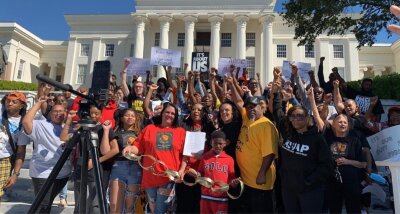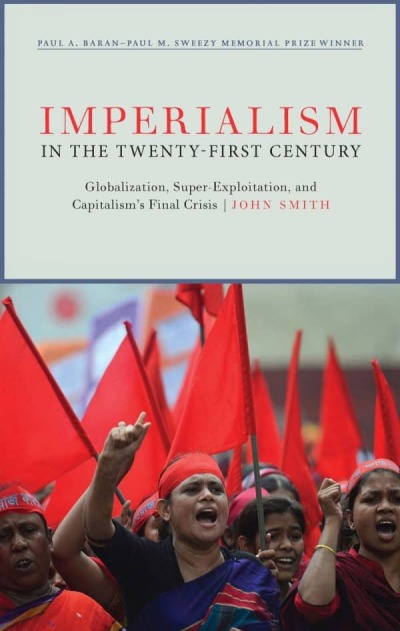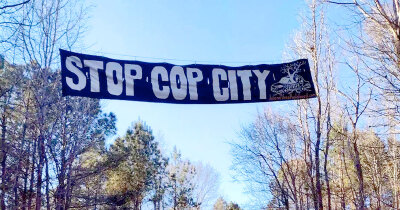
Alabama Prisoners Demand Freedom

Since Monday, 26 September 2022, Alabama has struggled to keep its prisons operating as prisoners across the state have not been performing work in their facilities until their demands for reform of the parole system, sentencing, and oversight are met. Organizing around this campaign began back in June among prisoners and their families, after years of protests and litigation over the escalating brutality of the Alabama Department of Corrections failed to make the state budge.
In the state of Alabama, prisoners manufacture license plates, furniture, clothing, while maintain the prisons themselves by working in the kitchen, laundry, or doing yard and road work. Without this work the prisons are dramatically short-staffed and can barely even keep prisoners fed. Meals being served to prisoners in recent weeks are basically slices of bread and cheese, a powerful indication of the willingness of the state and its employees to run the basic infrastructure prisoners need to survive.
The prisoners’ demands are not centered on overcrowding or the fact that Alabama doesn’t pay its prisoners anything for their labor, or specific acts of brutality by correctional officers, as galling as all of that is. Instead, they are targeted at the parole and sentencing systems, which have led to “more people coming out in body bags than on parole,” in the words of outside organizer Diyawn Caldwell of prisoner advocacy group Both Sides of the Wall.(1) The prisoner’s demands are:
- Repeal the Habitual Offender Law immediately.
- Make the presumptive sentencing standards retroactive immediately.
- Repeal the drive-by shooting statute.
- Create a statewide conviction integrity unit.
- Mandatory parole criteria that will guarantee parole to all eligible persons who meet the criteria.
- Streamlined review process for medical furloughs and review of elderly incarcerated individuals for immediate release.
- Reduction of the 30 year maximum for juvenile offenders to no more than 15 years before they are eligible for parole.
- Do away with life without parole.(2)
The sentencing and parole systems in Alabama have always been bad and have been getting worse in recent years. In mid-October while prisoners in some facilities were still refusing to work, the Alabama parole board granted two paroles out of 124 cases, a rate barely above one percent. Whether this was conscious retaliation or just the day-to-day brutality of the system is unknown at this time.

An investigation initiated by the Justice Department under the Trump administration identified horrific overcrowding (182% of capacity) and neglect that has led to some of the highest rates of homicide and rape among prisoners in the country.(3) Following this investigation, the Justice Department then took the extraordinary step of suing the state of Alabama over the conditions of its men’s prisons.(4) According to prison organizers, nothing has changed in the almost two years since the lawsuit.
Because of the prisoner participation across the state, the government wasn’t able to ignore it like they normally prefer. Governor Kay Ivey called the demands ‘unreasonable’ while also admitting that the building of two new mens’ prisons (with misappropriated COVID-19 relief funds) would meet the DOJ’s demands to end overcrowding.(5) Regarding parole and the basic fact that the state is putting more and more people inside with longer and longer sentences with no end in sight, she had nothing substantial to say.
The warehousing of predominately oppressed nation men, with no opportunities for rehabilitation or release is why we charge genocide against the U.$. criminal injustice system. Alabama is part of the Black Belt south, with 26% of it’s overall population being Black/New Afrikan. Yet, 54% of prisoners were New Afrikan across the state in 2010!(6) Alabama is in the top 6 states in the United $tates for overall imprisonment rates, with most of those states being in the Black Belt.
Caldwell discussed the despair prisoners in Alabama feel because of the lack of opportunities in Alabama prisons:
They’ve taken all the exit and second chance options away from these men and women in Alabama. There’s no hope for parole because the parole board is practically denying everyone and sending them off [with] five [more] years with no explanation, even though these men and women meet the set criteria that has been established.
They practically have a living death sentence, if they don’t have an EOS date, so all the hope is gone. They have nothing to strive for there, they feel like they’re not worthy of a second chance, they’re not given a second chance. And no one has any type of trust or hope in them to come out and reintegrate into society and be a stand-up citizen.
People incarcerated in Alabama face excessive force from correctional officers, a high risk of death, physical violence and sexual abuse from other prisoners and are forced to live in unsafe and unsanitary conditions, according to the DOJ.
The prison authorities have responded to the work refusal by cancelling all visitation, cutting programming back to nothing, and serving next to no food. The Alabama Department of Corrections is one of many prison systems across the country struggling to function without enough people to run its operations. While prisoners are the primary people to suffer under these conditions, this also indicates a contradiction in the United $tates use of prisons to control large populations that could offer opportunities for change. As Under Lock & Key goes to print, the prisoners have faced the state of Alabama down for three weeks. We will continue monitoring the situation and try to extract lessons for the rest of the country.
Notes:
1. Jessica
Schulberg, “Alabama Prison Strike Organizer: ‘They’re At War For Their
Life And Freedom’”
2. Julia
Conley, 28 September 2022, “Demanding Broad Reforms, Thousands of Inmate
Workers on Strike at Alabama Prisons”, Common Dreams.
3. Katie
Benner and Shaila Dewan, 3 April 2019, “Alabama’s Gruesome Prisons:
Report Finds Rape and Murder at All Hours”, The New York Times.
4. Department
of Justice Office of Public Affairs, “Justice Department Files Lawsuit
Against the State of Alabama for Unconstitutional Conditions in State’s
Prisons for Men”
5. Howard
Koplowitz, September 2022, “Striking Alabama inmate workers’ demands
‘unreasonable,’ Ivey says”.
6. Alabama Profile,
2010, Prison Policy Initiative.









